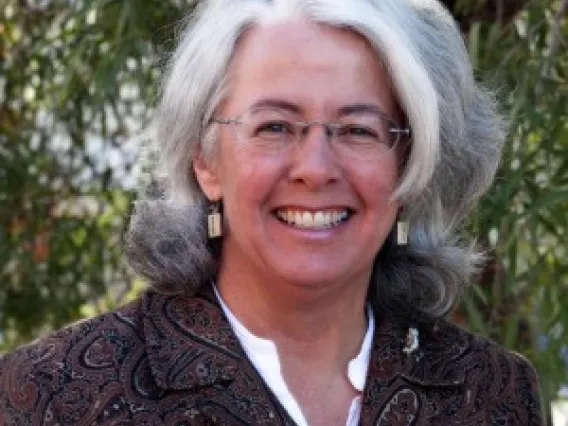Lauri Macmillan Johnson
Programs
-
Landscape Architecture
-
Real Estate Development
-
School of Landscape Architecture and Planning
-
Urban Planning

Biography
Lauri Macmillan Johnson is Professor and Director of the School of Landscape Architecture and Planning. Her research focuses on design theories of contemporary landscape architecture, cultural landscapes, and children's environments. She is author of Creating Outdoor Classrooms: Schoolyard Habitats and Gardens for the Southwest, University of Texas Press, 2008. Macmillan Johnson is co-designer of the winning entry Garden of Abandonment for Chaumont-sur-loire International Festival of Gardens (des Parcs et Jardins) held in France, 2003. She received a BSLA at Rutgers University and an MLA at the University of Illinois.
As an educator Macmillan Johnson teaches history and theory of landscape architecture, contemporary landscape architecture, and design studios. Her design studios focus on synthesizing art, culture, and nature into meaningful landscape experiences. Students, in her studios, received finalist and merit awards for design completions in Recycle This Site, Asheville, North Carolina, 2010, with Professor Nader Chalfoun; Integrating Habitats, Metro and City of Portland, 2007, with Professor Margaret Livingston; and Ross Bridge Greenspace Master Plan, Birmingham, Alabama, 2005.
She serves as Principal Investigator on grants and contracts with the National Park Service for master planning projects, and cultural landscape inventories/reports. Projects were conducted at Fort Davis National Historic Site, Texas; Tumacacori National Historical Park, Arizona; Trail Ridge Road, Rocky Mountain National Park, Colorado; Missions San Juan and Espada, San Antonio Missions Historical Park, Texas; Faraway Ranch, Chiricahua National Monument, Arizona; Fort Bowie National Historic Site, Arizona; and with Professor Brooks Jeffery, Bryce Canyon National Park, Utah.
Selected presentations and writings include: "Redefining National register of historic boundaries with the cultural landscape report in Bryce Canyon National Park," Council of Educators in Landscape Architecture, with Wendy Lotze, 2009; "Nature play places: children's gardens", Spring Lecture Series: Creating Gardens Past and Present, Arizona Historical Society, 2009; Outdoor classroom design: strategies for success, South Florida Environmental Art Project, Inc., West Palm Beach, Florida, 2008; "Therapeutic gardens for children with Autism Spectrum Disorders, Proceedings Council of Educators in Landscape Architecture, with Beverly J. Wilson, 2007; "Art as a catalyst for public acceptance of ecologically designed landscapes," World Conference on Ecological Restoration in Zaragoza, Spain, with Monica Mahoney, 2005; "The Solis garden in Alamos, Mexico: a surreal garden with a contemporary interpretation of the sublime," in Journal of the Southwest, with John Messina, 2003; "American playgrounds and schoolyards—a time for change" in Open Space: People Space, an International Conference on Inclusive Environments, Edinburgh College of Art, Edinburgh, Scotland, 2004; and four book chapters including "Burle Marx, Roberto 1909-1994," "Design Fundamentals," "Rose, James 1910-1991," "United States," In Encyclopedia of Gardens: History and Design, edited by Candice Shoemaker, Chicago Botanical Garden, Fitzroy Dearborn Publishers, 2001.
Creating Outdoor Classrooms, Schoolyard Habitats and Gardens for the Southwest
Bryce Canyon National Park: Old NPS Housing and Bryce Canyon Lodge Cultural Landcape Report
Encyclopedia of Gardens: History and Design
Fort Davis National Historic Site:
Fort Davis National Historic Site (NHS) is located in Fort Davis, Jeff Davis County, Texas. The historic landscape rests among the arid desert grasslands of the Trans Pecos region of southwestern Texas. Nestled within a box canyon on the south¬eastern edge of the Davis Mountains, this site has long attracted the attention of early Native Americans, Spanish explorers, and American settlers.Fort Davis NHS contacted the School of Landscape Architecture and Planning for the development of a conceptual master plan for interpretative spaces and signage that educates visitors about the fort site history but also interprets the biological and geological significance of the surrounding land. The core historic area of approximately 40 acres contains 24 roofed buildings and over 100 ruins. The master plan, developed by the School included circulation routes and wayfinding strategies within multiple trails totaling about 3 miles in length. Numerous attractions were proposed including a new Visitor's Center, Buffalo Soldier Memorial, interpretation of historic flood control dikes and ditches, nature nodes, a time line of regional Native American habitation, daily activities, and cultural traditions. The outdoor interpretative spatial sequences permit park adventures to explore the historic site and surrounding rugged hills with a sense of discovery.
Zoo
Zoos are among the most complex institutions in the world where the relationships between humans and animals are articulated. Through the decades zoos have evolved from earlymenageries confined by undersized cages to modern day exhibits that strive to simulatenatural habitats while also educating visitors about the importance of conservation and wildlife protection. The Reid Park Zoo, Tucson, Arizona, contacted the School of Landscape Architecture and Planning, CALA, for guidance in the design of interpretative spaces and exhibits for the new elephant habitat called Expedition Tanzania.
The University research and design team developed several detailed spaces and exhibits that seek to actively engage visitors of all ages in fun learning scenarios. The interpretative approach applied theories on effective engagement strategies through diverse experiences that aim to gratify audience values. Documentation of this approach through text and design plans/sketches have been used by the Zoo, Curator of Education, in public fundraising events and in presentations with the Tucson Mayor and City Council. We have been praised, by Zoo staff, for our contributions as the exhibit is going forward "without a single penny from the City's General Fund!"—groundbreaking is scheduled for summer 2010.



